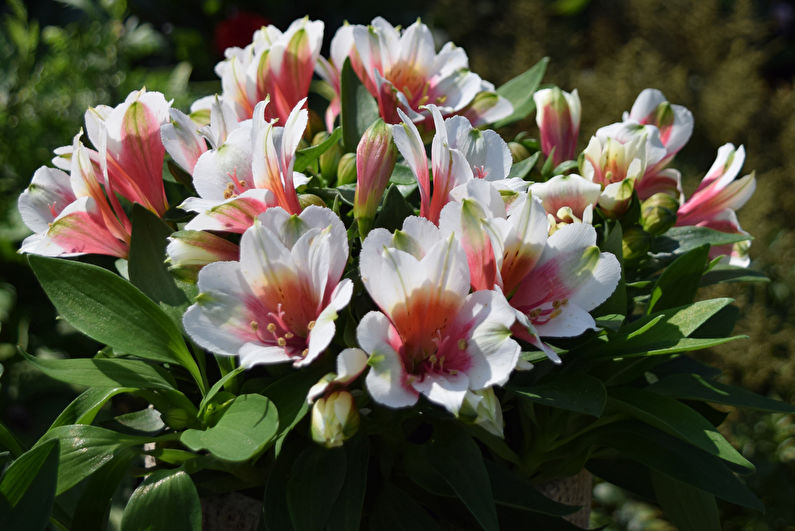Alstroemeria a beautiful flower with a cosmic name for your pot and garden
An excellent flower with a beautiful and slightly cosmic name, alstroemeria, combines the oriental-exotic unique grace of orchids and the proud being of lilies. It will become a real decoration of balconies, gardens, flower beds, and will also make an excellent bouquet, as it is able to maintain its color in cut form for up to two weeks. Consider what this natural perennial from the South American continent, with bright delicate flowers, as well as the rules of care and reproduction, could be.
Types of alstroemeria
The variety of culture in wildlife is represented by more than 75 wild species, the height of which rarely reaches 1 m, which cannot be said about cultivated varieties. Varietal and hybrid alstroemeria often reach 2 m, have medium-sized flowers (maximum 5 cm in diameter) of various colors. Such species are tall, and they are usually placed in the background of flower beds.
There are also undersized representatives decorating mixed plantings with beautifully blooming summer houses, window sills of apartments, yards. They are also used to create borders.

Find out more about the African Lily – a graceful summer flower
Proper care for alstroemeria
Before planting the first bush of this wonderful culture, you need to familiarize yourself with important information on how to properly care for it. Only by creating the necessary conditions for the plant, you can protect it from various diseases and admire the beautiful flowering.
Lighting
Alstroemeria will feel comfortable in well-lit areas. On especially hot days, it is necessary to create partial shade for garden residents, and apartment residents can simply be moved to a darker place. In the autumn-winter period, alstroemeria is kept on the south window, and in spring and summer, the direct sun should alternate with bright diffused light at noon hours.
Temperature
Most species of alstroemeria are very thermophilic, although there are hybrids that can withstand frosts down to -20C. The optimal range for normal development will be + 20 ° … + 22C, and in winter about + 14C. During the budding period, as well as flowering, the temperature should be around + 16C.

Watering
Alstroemeria loves regular, moderate watering, which stops with the onset of autumn cold weather. Care must be taken to avoid overflow or drought. A sufficient dose will be once a week, and if hot weather sets in, it can be increased up to two times. In this case, the soil must be constantly moistened to a depth of 2 cm, otherwise, the plant will lose its decorative effect.
Fertilizers and feeding
The first compost fertilizer must be present in the soil at the time of planting. Next, you need to regularly feed the flower, thereby ensuring lush flowering. The procedure is performed several times a month. It is recommended to use a complex fertilizing of a mineral type, containing the necessary components of potassium, phosphorus, nitrogen, and other substances. It will not hurt to add wood ash to the shrub from time to time. Organic supplements such as poultry droppings or mullein at a low concentration can also be added as a small amount.
Catananche, an extremely interesting plant, for your pot or garden, that deserves to be more popular

Pests and diseases
The plant can be susceptible to diseases such as late blight, fusarium, root rot. A common cause of their occurrence is improper care, in particular, excess moisture in the soil, stagnant water. This also applies to diseases such as botrytis (gray rot), which can occur with high humidity, insufficient drainage, and also if planting in the open ground was carried out during heavy rains. A diseased plant must be treated several times a week with a fungicide solution, spraying it and watering the roots. With this ailment, a flower at an early stage of development is rarely saved – most often it is removed from the garden.
The main pests that most often harm the culture are thrips and spider mites. The presence of the former can be determined by the presence of silvery spots on the leaves, traces of punctures. Ticks are caused by keeping the plant in hot conditions. You can fight pests with the help of insecticides (confidor, aktara), watering the soil with them.
How to transplant alstroemeria
Potted crops are transplanted annually in the spring, adding pine bark, humus, peat to the new soil. There must be good drainage at the bottom of the pot.
When choosing a place for planting in flower beds, you need to take care that the soil is loose and light – this is the key to excellent flowering. Cultures are transplanted that, as a rule, have reached the age of three. After planting, regular, moderate watering is required. Using mulch will help drown out weeds, create a layer that keeps the soil loose.

Oakleaf Hydrangea, a durable and safe for beginners flower in your garden
Reproduction of alstroemeria by division
In order to propagate alstroemeria in this way, it is necessary to dig in the spring of the mother bush, which is at least 3 years old, carefully separating the large rhizomes. Moreover, there must be at least one kidney on the parcel. Places of cuts of the main bush are sprinkled with coal or treated with a disinfectant. New bushes are planted in prepared moist soil to a depth of no more than 20 cm. The first flowering of the bush will take place next year, although some species planted in this way in autumn may bloom in spring.
How beautifully exotic alstroemeria blooms in garden plots and at home, we invite you to familiarize yourself in our photo gallery. Here you can find a variety of species and varieties, their placement in composite flower beds and as beautiful decorations for interiors, gardens, and balconies.

























